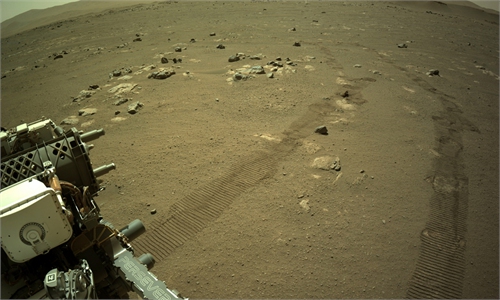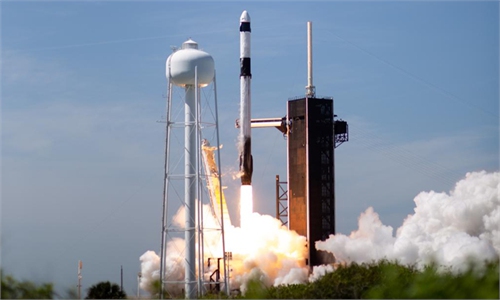
A NASA helicopter flies past the agency's Space Launch System rocket on August 29, 2022. NASA called off the test flight on Monday of its largest-ever Moon rocket, citing engine problem. Photo: AFP
Due to the failure to troubleshoot an engine problem, NASA's Space Launch System (SLS) rocket carrying the Orion capsule remained on the ground at the Kennedy Space Center in Florida on Monday, disappointing people who gathered at the center and those who tuned in live to watch US' rekindling of lunar surface landing project since the Apollo program some half a century ago.
"The launch of Artemis I is no longer happening today as teams work through an issue with an engine bleed. Teams will continue to gather data, and we will keep you posted on the timing of the next launch attempt," NASA posted on Twitter. According to the New York Times, NASA has another window in early September, but it also depends on whether bugs are fixed.
Before the postponement was decided, NASA repeatedly stopped and restarted the fueling of SLS with nearly 1 million gallons of super-cold hydrogen and oxygen due to the leak in Kennedy Space Center, US media said.
The postponed launch came after China's state-owned space giant China Aerospace Science and Technology Corporation (CASC) announced about a week earlier that China's new-generation manned rocket, which is currently under development, will possess the capability to send taikonauts to the moon by around 2030.
Qian Hang, a senior Chinese expert on aerospace science, told the Global Times that the success of the Apollo Program (1961-1972) helped the US to outcompete Soviet Union, but it also cost the US countless economic and technological resources. Therefore, after the lunar landing, the US shifted its focus from the moon to the space shuttle, space station project, Mars exploration and other projects.
In recent years, many countries, including China and India, have developed rapidly in the space industry, putting pressure on the US. Especially after China made a breakthrough with its Chang'e-5 unmanned lunar mission, which brought back lunar soil samples.
Hours before the scheduled launch, Chinese Foreign Ministry Spokesperson Zhao Lijian stressed on Monday that the outer space is not an arena for countries to wrestle, but an important field for win-win cooperation. And the exploration and peaceful use of outer space is the common cause of mankind and should be pursued for the benefit of all mankind.
Zhao's remarks were viewed as a response to NASA's Administrator Bill Nelson who has recently expressed "concerns" about the "space race" that China would arrive first and claim the moon's territory. If NASA's following missions are carried out as scheduled, US astronauts could land on the moon again as soon as 2025, five years earlier than China's plan.
China has always been committed to the peaceful use of outer space and has conducted extensive cooperation with other countries to safeguard outer space security, Zhao said, noting that China hopes all countries will continue to work together to promote the peaceful use of outer space and make greater contribution to the building of a community with a shared future for mankind.

Beachgoers wait for the launch of the Artemis I unmanned lunar rocket, in Florida. Photos: AFP
Arduous task
According to NASA, the Orion will reach a retrograde orbit around the moon, traveling 2.1 million kilometers in 42 days. The mission will test the heat shield function of Orion capsule, and carry some small satellites to be placed in moon's orbit.
If everything about the Artemis I mission goes on well, the second scheduled flight, the Artemis II is expected to launch SLS megarocket around the moon as early as 2024, testing key systems of the Orion spacecraft with humans on board.
The Artemis III launch date is set for 2025 if the previous programs go as plan. Besides, space experts said optimistic progress on new spacesuit development and human landing systems are also necessary.
However, according to evaluation from NASA's inspector general office, due to anticipated delay of the spacesuit development, NASA's hopeful timeline is "not only unlikely, but even impossible."
Besides, the Lunar Gateway, a human-tended space station orbiting the moon that provides necessary support for long-term human return to lunar surface and a staging point for deep space exploration, has dragged the two Artemis missions to an "unsustainable crawl," due to its building cost, according to the Hill.
Citing NASA's Inspector General, CNBC reported that the space agency is projected to spend $93 billion on the Artemis up to the fiscal year 2025. And the cost of a single SLS launch is about $4.1 billion, which NASA inspector general Paul Martin expressed his concern and described it as "unsustainable."
Wang Yanan, chief editor of Beijing-based Aerospace Knowledge magazine, told the Global Times on Monday that "return to the moon" will not be an easy task for the US despite its advancement in science and technology.
With so much money invested in Mars exploration and the International Space Station missions, it is doubtful that there will be sufficient and timely resources to achieve America's challenging goals of returning to moon in 2025, Wang said.
To cope with difficulties, the US has involved commercial space efforts. US media said that Elon Musk's SpaceX, which has participated in Artemis III mission's landing site selection, plans to build a vehicle that will land US astronauts on the lunar surface. Besides, NASA also had its astronauts visiting SpaceX facilities for hardware tests.
Involving commercial efforts showed NASA's forward-looking vision, but whether NASA has a set of efficient management mechanism of regulating these enterprises is uncertain. For NASA, it may be about engineering and technical maturity and reliability, but companies may be more concerned about share price and financing, Wang said.
'Space race'
In an interview with NBC's "Meet the Press" on Sunday, NASA's Administrator Bill Nelson said that China's space ambitions have provided motivation for Artemis, according to the New York Times. Nelson said he doesn't want Chinese astronauts to arrive first and claim the territory and resources, describing that there's a "space race" between the two countries.
In an interview with a German newspaper in July, Nelson smeared China for "trying to take over the moon" and saying China's mentality is like "it's ours now and you stay out."
Experts said Nelson's inflammatory remarks are full of smears against China, which is actually not as fast as the US in scheduled time for landing on the moon. CASC disclosed on August 21 that China's new-generation manned rocket, which is currently under development, will possess the capability to send taikonauts to the moon by around 2030.
The SLS-level megarocket is still under development in China, but in the US, one is now standing on the launchpad, a senior Chinese expert on aerospace science and technology based in Beijing, told the Global Times on condition of anonymity.
The malicious speculation and smearing of China from Nelson are totally ill-intentioned, the expert said, "Since the dawn of the age of human exploration of space, no country has ever claimed some of the resources of outer space, especially when there's regulation from UN framework convention on cooperation in outer space."
By using such colonialist rhetoric to smear China, the US wants to pressure countries interested in cooperating with China in space, and force some countries to take sides on the issue of space exploration, the expert told the Global Times on Monday.
China has its own pace and has no interest in competing with the US to land on the moon faster, the Beijing-based expert said. "China hopes to make lunar exploration a long-term and internationally cooperative project. China's larger goal is to benefit more people rather than to compete for resources like the US."
In January, China and Russia revealed a plan to jointly build a moon base by 2027, media reported. Dubbed the International Lunar Research Station, it will be a complex of research facilities for moon exploration, observation and experiment.
Some other developing countries do not have the technical capacity and economic resources to build an outer space exploration program from scratch, but the cooperation between China and Russia will give more developing countries the opportunity to participate, he said.




